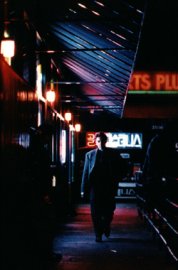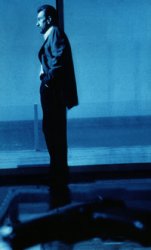Heat: Special Edition DVD
reviewed by j.d. lafrance

After the commercial and critical success of The Last of the Mohicans (1992), filmmaker Michael Mann made his most ambitious film up to that point in his career with Heat (1996). He cast legendary actors Robert De Niro and Al Pacino as the leads in what would be their first the on-screen appearance together in a movie (they were in The Godfather: Part II but never appeared in the same scene). Mann returned to a 1986 draft of a screenplay that originated before he made The Jericho Mile (1979). He now had a much clearer idea of how he wanted Heat to be structured and decided to expand its scope.
At the core of Heat is the relationship between career criminal Neil McCauley (Robert De Niro) and dedicated cop, Vincent Hanna (Al Pacino). Mann takes the career criminal from Thief (1981) and the intensely dedicated cop from Manhunter (1986) and places them in the same film together with the sprawling metropolis that is Los Angeles as its backdrop. It is a deadly cat and mouse game realized on an epic level. Imagine Stanley Kubrick’s The Killing (1956) but on the scale of 2001: A Space Odyssey (1968).
The opening of Heat introduces the two main protagonists without any dialogue. Mann relies entirely on their actions to illustrate defining characteristics. From the beginning, he shows a sharp contrast between McCauley and Hanna’s professional and personal lives. McCauley is all business. His life is devoted to preparing for his next score. Hanna is married—albeit in a relationship rife with problems but with some semblance of a personal life.
Hanna’s element is not in a domestic setting and this becomes obvious when he appears at the crime scene of an armored car heist perpetrated by McCauley and his crew at the beginning of the movie. As soon as Hanna walks on the scene he immediately takes control. It is a real treat to see Pacino act out this scene. He takes control both physically—in the way he gestures and moves around—and verbally, in the authoritative tone that he uses with the people around him. Pacino displays the confidence of an actor totally committed to his role, which is appropriate as his character is someone who is completely committed to his profession.
If Hanna is all about the verbal side of the professional Mann protagonist, McCauley is the flip side of the same coin. He is the quiet individual who lets his actions speak for him. Mann defines McCauley’s character visually. This is achieved not only in the exciting armored truck heist sequence—the essence of ruthless efficiency—but, more significantly, when he returns to his home. Like most Mann protagonists he lives in a Spartan, empty residence. The establishing shot utilizes a blue filter that saturates the frame, with the ocean infinitely stretching out in the background. This is reminiscent of the scene in Manhunter where Graham and Molly make love in their bedroom. McCauley is a man dominated by his profession—it defines who he is as a person.
In the relationships between men and women it is the men who always find a way to screw things up in Mann’s films. They are always focused on their job and do not spend enough time on their personal relationships until it is too late. Justine (Diane Venora) articulates this best when she tells Hanna, “But you have got to be present like a normal guy some of the time. That’s sharing. This is not sharing. This is leftovers.” Hanna responds, finally articulating to her how he works, “And in sharing it we’ll somehow cathartically dispel all that heinous shit, right? Wrong. You know why? ‘Cause I got to hold onto my angst. I preserve it because I need it. It keeps me sharp, on the edge, where I gotta be.”

Mann wants to have a balance between the cops and the criminals but ultimately the film sides with McCauley and his crew. Aside from McCauley’s relationship with Eady (Amy Brenneman), Mann also devotes time to the turbulent relationship between Chris (Val Kilmer) and Charline (Ashley Judd). On the cops’ side, only Hanna and Justine are given any kind of decent amount of screen time. The rest of his crew are given very little and are peripheral to the main story of McCauley versus Hanna.
The film’s centerpiece is undeniably the classic meeting between Pacino and De Niro. Ironically, Mann cuts the scene so that each man is shown in over-the-shoulder shots. We do not actually see them face-to-face at any time during this scene. This is the moment when both men size each other up and reveal their personal philosophies. The dialogue between them says a lot about who they are. It makes sense, then, that they understand each other better than their wives or girlfriends. McCauley and Hanna are more open with each other than with their loved ones because there is a mutual respect and bond between them that others would not understand.
Heat’s most exciting action sequence is the now famous bank heist scene. Right from the beginning, Mann establishes a quick pace as McCauley enters the bank accompanied by pulsating electronic music that anticipates what is going to happen. The music is underplayed but still effective in creating tension during this sequence. Once McCauley and his crew emerge from the bank and Chris fires the first shot, the music stops and the rest of this exciting sequence plays out with no music—only the deafening roar of the guns firing as McCauley and his men try to escape and turn the streets of Los Angeles into a war zone. Mann alternates between shaky, hand-held cameras and fluid tracking shots with kinetic editing that brilliantly conveys the exciting action that is taking place.
A few years ago Warner Brothers released a bare bones DVD of Heat. To celebrate the 10th anniversary, Mann has personally revisited his movie and assembled an excellent collection of extras.
The director contributes a characteristically solid audio commentary. He points out that many of the characters are based on actual people. For example, Nate (Jon Voight) is homage to real-life criminal Eddie Bunker (who had a brief role as a crook in Reservoir Dogs) who acted as a consultant on the movie. Mann provides a lot of details into the backgrounds and motivations of the characters. Surprisingly, there is very little overlap from the featurettes as Mann’s comments start off strong but become more infrequent after the 90 minute mark.
The strongest extra is The Making of Heat, an excellent 54-minute retrospective documentary that can be viewed in three separate featurettes or altogether. Many of the major and minor cast members are back for brand new interviews and offer insightful comments, including Al Pacino, Jon Voight, Ashley Judd, Val Kilmer and Tom Sizemore amongst others. Mann talks about one of the inspirations for Hanna, his long-time friend and veteran cop, Chuck Adamson (who is also interviewed) and the real-life Neil McCauley. Pacino explains his character’s sudden, outrageous outbursts that part of Hanna’s backstory is that he did cocaine and was always a little high. Mann and his cast did extensive research, including the actors who played criminals meeting real ones in prison. One quickly gets the impression that Mann is incredibly well-prepared and knows exactly what he is doing and his confidence inspires the cast and crew. This is in-depth look at how Heat was put together and provides the whole story for casual fans and fascinating insight for devotees.
Pacino and De Niro: The Conversation explores the famous on-screen meeting between these two actors. Their characters may be on the opposite sides of the law but there is a mutual respect one another. Mann subverts our expectations by delaying their eventual meeting and then, when it does happen, it is at a diner over coffee and not what one expects with this kind of a movie, like in a shoot-out.
Return to the Scene of the Crime features location manager Janice Polley revisiting many of the locations used in the movie. Mann wanted to find locations in Los Angeles that had never been put on film before in order to create a distinctive look. Not an easy task for one of the most photographed cities in the United States (second only to New York City). In a fun bit, Polley even sits at the table where Pacino and De Niro have their conversation over coffee.
Finally, there are 11 deleted scenes that give a brief glimpse into Michael’s (Tom Sizemore) home life and a little more footage of Hanna and his guys socializing together with their wives. Perhaps the most revealing excised bit of footage is a scene where McCauley and his crew get ready just before they enter the bank while one of his gang (Danny Trejo) is interrogated by rogue psycho Waingro (Kevin Gage) that should have been kept in. There is nothing terribly earth-shattering about this excised footage but there are a couple of good moments.
The scale and star power of Heat was unlike anything Mann had ever tried before and firmly announced him as force to be reckoned within Hollywood. This two-DVD set is a fitting tribute for this important film. The transfer and sound are very well done with extras that are substantial and plentiful, providing a really good look at how this epic movie was put together.
Copyright (c) 2005 erasing clouds |
|